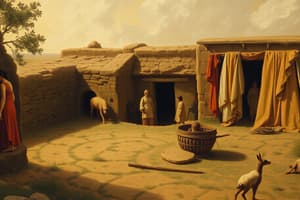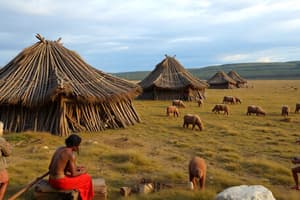Podcast
Questions and Answers
Where was the Clovis culture initially discovered?
Where was the Clovis culture initially discovered?
- Clovis, New Mexico (correct)
- California
- Arizona
- Texas
Approximately how many years ago did the Clovis people migrate across the Americas?
Approximately how many years ago did the Clovis people migrate across the Americas?
- 5,000 years ago
- 8,000 years ago
- 12,000 years ago
- 10,000 years ago (correct)
What type of tools were commonly used by the Clovis people?
What type of tools were commonly used by the Clovis people?
- Longbows
- Clovis Points (correct)
- Spear throwers
- Stone axes
Which route do findings suggest may have been used by early peoples before the Clovis culture?
Which route do findings suggest may have been used by early peoples before the Clovis culture?
What climatic conditions did the Clovis culture experience as they migrated?
What climatic conditions did the Clovis culture experience as they migrated?
What does the Clovis theory suggest about the migration of humans to the Americas?
What does the Clovis theory suggest about the migration of humans to the Americas?
Which event contributed to the formation of a land bridge between Siberia and Alaska?
Which event contributed to the formation of a land bridge between Siberia and Alaska?
What is the significance of the Clovis culture?
What is the significance of the Clovis culture?
What additional route is theorized for European populations reaching the Americas?
What additional route is theorized for European populations reaching the Americas?
What supports the theory of an early migration to America?
What supports the theory of an early migration to America?
Which route is considered the most likely explanation for early settlement in America?
Which route is considered the most likely explanation for early settlement in America?
What is one alternative migration method suggested in the theories?
What is one alternative migration method suggested in the theories?
What similar artifacts support the idea of transatlantic migration?
What similar artifacts support the idea of transatlantic migration?
When is it believed that the process of migration to America began?
When is it believed that the process of migration to America began?
What was the primary method of sustenance for the first inhabitants of the Americas?
What was the primary method of sustenance for the first inhabitants of the Americas?
What characterized the social structure of early human groups in the Americas?
What characterized the social structure of early human groups in the Americas?
How did the early inhabitants of the Americas ensure their survival through hunting?
How did the early inhabitants of the Americas ensure their survival through hunting?
What factor dictated the seasonal migrations of early human groups?
What factor dictated the seasonal migrations of early human groups?
Which of the following practices from the early nomadic lifestyle is still present in some cultures today?
Which of the following practices from the early nomadic lifestyle is still present in some cultures today?
Flashcards are hidden until you start studying
Study Notes
Theories of Populating America
- Clovis theory: proposes humans migrated from Asia across Beringia (land bridge between Siberia and Alaska) around 14,000 to 13,500 years ago, traveling across a land bridge that emerged when sea levels dropped.
- Pre-Clovis theory: suggests an earlier arrival in the Americas, possibly through a coastal route using boats across the Pacific Ocean.
Clovis Culture
- Early culture in the Americas known for stone tools.
- Spread across most of present-day Mexico and the American Southwest.
- Migrated from Alaska and settled around 10,000 years ago.
- Followed the receding glacier after the last ice age.
- Not the first inhabitants of the Americas, evidence points to an earlier arrival.
Theories on the Settlement of America
- Ice-free corridor in North America: opened up approximately 1,000 to 2,000 years after the first evidence of human settlement in America, suggesting a prior migration.
- Circum-Pacific route: appears to be the most likely explanation for early settlement.
- Alternative routes: include travel across the islands of Melanesia and Polynesia in primitive rafts, and utilizing floating ice across the Atlantic Ocean to reach the eastern coast of the United States.
- Similarities between Clovis points and Solutrean points: found in France and Spain, dating back approximately 22,000 to 18,000 years ago, support the theory of European migration.
Cultural Characteristics of the First Settlers of America
- Nomadic lifestyle: Early human societies were nomadic, moving from place to place to access resources.
- Hunting, fishing, and gathering: primary methods of sustenance.
- Small groups: typically consisting of no more than 50 people, united by familial ties.
- Resourcefulness: developed complex hunting strategies, including coordinating the movement of hunting groups to stampede herds of animals.
- Seasonal migration: dictated by the seasonal availability of food and other resources.
- Close ties to the land: early groups developed a deep understanding of their environment and the natural cycles.
- Specialized hunting: groups were organized for specialized hunting tasks, demonstrating cooperation and collective skills.
- Rituals and ceremonies: celebrated survival and abundance.
Studying That Suits You
Use AI to generate personalized quizzes and flashcards to suit your learning preferences.




